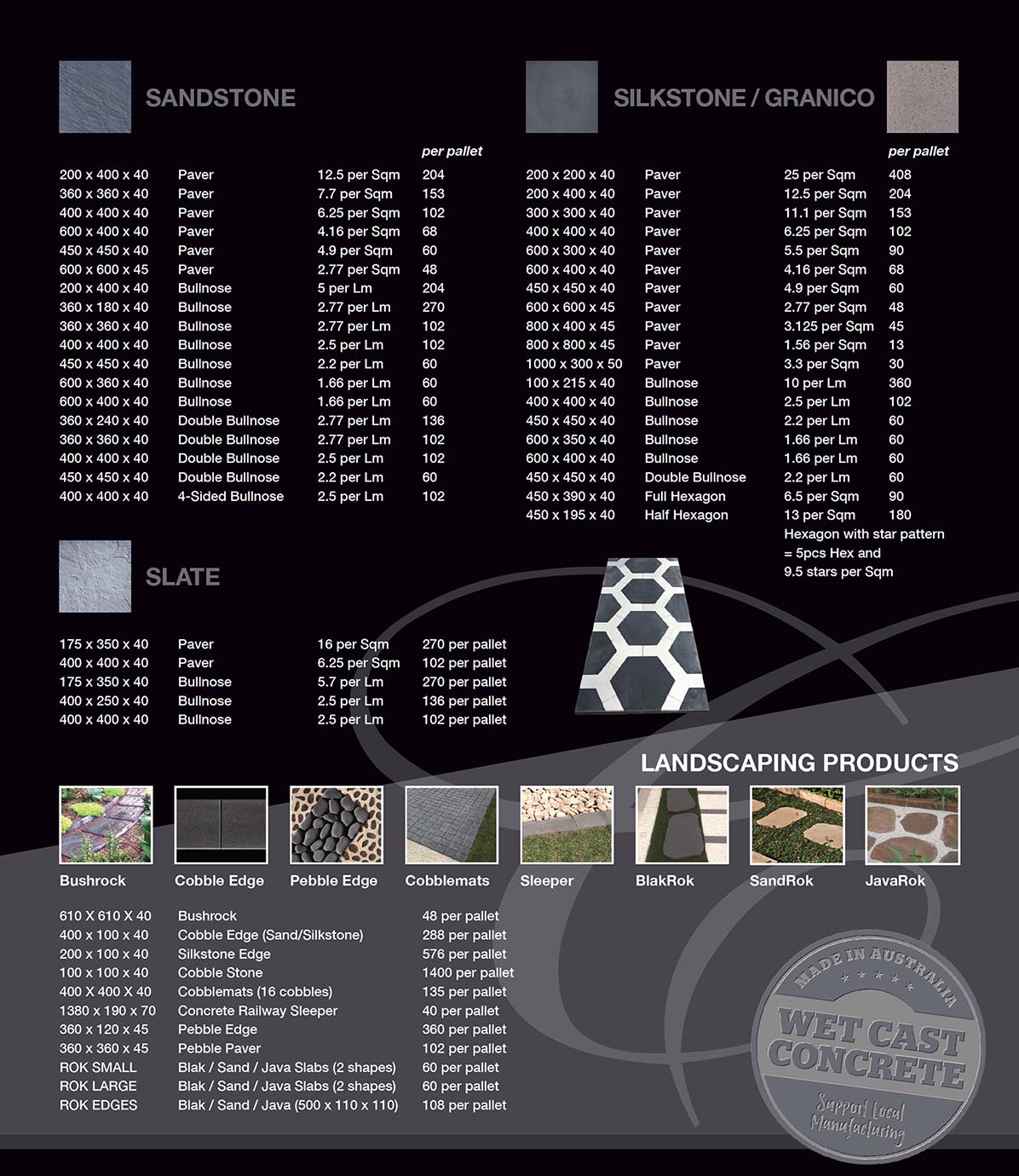Paving Group manufacturers guide
Paving Group Pty Ltd trading as “Custom Paving” & “Stone Directions”
This guide contains tips and methods to get the best out of your paving, facts, and a DO NOT section. Please read this guide fully before attempting any project by yourself or in consultation with your professional contractor. Our websites, brochures and delivery dockets contain similar information.
Wet Cast pavers, coping and associated concrete products are hand made in moulds using natural products, including aggregate, sand, cement, water and oxides. Wet Cast paving is much stronger, denser and more durable than cheaper dry cast product. Our pavers are suitable for domestic, commercial and industrial uses including pool areas and have been tested to Australian Standards. We use quality raw materials including washed aggregate, granite screenings, graded washed sand and white Portland cement which gives superior strength to grey cement.
Pavers have been tested and far exceed standards in compressive strength and breaking loads. Our pavers have also been tested for abrasion resistance and salt attack, receiving highest “Exposure” grade and are suitable around pools and other wet areas. All paving products have the best “V” slip rating, meaning pavers have low contribution to slip.
With the use of natural products, some colour, tonal, size variations and air bubbles can be expected. Tolerances as per Australian standards include thickness +/‐ 2.5mm, dimension (plan) +/‐ 3mm and up to 4% chipped or damaged. Industry-standard is to order approx. 5% greater than the required area to accommodate cuts and damage due to handling. If you find any product that is outside tolerances or damaged, put them aside for cuts. Please note some textures have natural high and low points at edge due to surface design. Thicknesses are calculated on a mean basis.
For best results, pavers should be laid on a concrete base using suitable adhesive. A flexible cement-based tile adhesive is preferred, or cement mortar but it should be free of salts. Using a 10mm notched trowel and sufficient adhesive/mortar to provide a solid bed of at least 3mm and level pavers individually. Alternatively, road base of 100mm depending on use, well compacted in layers can be used with a screed of clean washed sand to approx. 20‐25mm. A grout line of 8mm to 12mm is recommended and small joint width variations will become unnoticeable after grouting. Using a flexible grout is preferred to help prevent cracking. All grout and gap sand residues should be thoroughly cleaned with water frequently to avoid edge staining of pavers. Same for when cutting pavers with a wet cut saw, remove residue immediately. Clean any dirt or residue from backs of pavers when using adhesives. Always ensure good drainage and fall lines to drains on paving jobs to prevent pooling and future paver staining/darkening due to moisture.
DO NOT
- Leave pallets unwrapped for any period not being used or longer than 1 week should be put under cover
- Lay pavers on crusher dust, metal dust or cracker dust as mottling will occur
- Butt joint pavers as this will cause chips and not allow any variations to be taken out with sand or grout
- Stack crisscrossed or place objects on new pavers as framing/ hydration marks will occur in drying process
- Lay from one pallet if you have multiple pallets, try to blend pavers from each pallet when laying
- Place pavers face down or face to face or move around job sites in wheelbarrows unprotected – use foam
- Use high-pressure blasters close to paver surface as damage will occur ‐ keep the nozzle at least 500mm away
- Use plate compactors on large format pavers as it will cause chipping and damage.
- Use Hydrochloric Acid to clean any masonry product or surface paste damage will occur
Clean pavers with hot water and a scrubbing brush. For stains and pre-cleaning before sealing, we recommend ANTI EFF. For protection and ease of cleaning, a quality penetrating sealer should be used, especially in high use areas, areas prone to moisture and especially around pool areas subject to salt and chemicals. See the relevant manufacturers guide.
If you are matching pavers from an existing job, make sure you match a current paver to one on the display boards or seek to get a current sample as colours can vary over the course of a few years. Do not rely on website pictures or brochure colours completely to make your choice.
Manufacturers guarantee is limited to product replacement only and does not include installation. Any claims are to be made within 5 working days. Failure to comply with any of our recommendations will void any claim or warranty.
Do not make claims for any issues with product AFTER laying has occurred. Contact your reseller or supplier.
Conditions of Sale
- Please check your order for quality, colour, texture and general condition within 24 hours of delivery.
- Any irregularities in the product should be directed to the store of purchase within 5 days of delivery.
- No claims will be accepted for irregularities, issues or damage after laying.
- No other costs and no implied or expressed warranty or guarantee is given with the product.
- Liability is limited to product replacement only.
- Acceptance of product is acceptance of conditions of sale even if not signed for.
- Keep product wrapped and covered until needed.
- This is a handmade wet cast concrete product using cement and natural materials, therefore, some colour, size variations and air bubbles can be expected.
- Laying should be done by a licensed tradesman or person competent in laying larger format wet cast pavers.
- Tolerances as per Australian Standard include: thickness + or – 2.5mm and dimension + or – 3mm and chipped or damaged pavers up to 4%.
- Larger format 600mm and 800mm pavers are recommended as steppers as thickness can vary 3-5mm and up to 10mm.
- It is recommended that pavers are blended from different pallets when laying.
- DO NOT lay on Crusher Dust/ Cracker Dust/ Blue Metal.
- Wash grout or cut marks immediately to avoid edge staining.
- Lay on concrete using a suitable adhesive with an 8-12mm grout line or road base and sand only with 3mm gap minimum.
- DO NOT butt joint.
- To help avoid efflorescence, product must have good drainage and sealed with a quality penetrating sealer. This is no guarantee it won’t appear.
- Don’t leave pavers on wet ground or stack criss crossed as hydration marks/lines will transpire and ensure foam is used to move around job site or restack.
- DO NOT stack face to face.
- Clean marks with hot water and scrubbing brush, or use a diluted pre cleaner/sealer such as ANTI EFF.
- DO NOT ACID WASH.
- Delivery is to road side only, beyond this is at customers risk.

